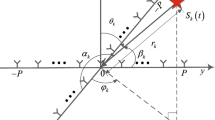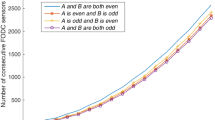Abstract
In this paper, a partitioned matrices products approach based on Gerschgorin disk estimation (PM-GDE) method is proposed in order to solve the problem of correlated source number estimation under spatially correlated noise background. This method is based on a uniform linear array. The improved partitioned matrices products of the array receiving data are computed by weighted summation of the rows and adjustment of the element sequence from partitioned matrices products matrix. The auto correlation matrix of the partitioned matrices products and its Gerschgorin radii are computed. A source number estimation criterion based on Gerschgorin radii is deduced by considering the second-order statistical property of the partitioned matrices products auto correlation matrix. Simulations results validate the efficiency and robustness of PM-GDE with correlated signals and spatially correlated noise background. PM-GDE performs better than its counterpart especially for close incident azimuth correlated sources.





Similar content being viewed by others
References
Xiao, Y., Yang, Z., Dan, L., Yang, P., Yin, L., & Xiang, W. (2014). Low-complexity signal detection for generalized spatial modulation. IEEE Communications Letters, 18(3), 403–406.
Fulai, L., Changyin, S., Jinkuan, W., & Ruiyan, D. (2012). A robust algorithm based on spatial differencing matrix for source number detection and DOA estimation in multipath environment. Physics Procedia, 33, 991–999.
Xiaoyu, L. (2013). A source number estimation method based on total least squares fitting. In: IEEE international conference on mechatronic sciences (pp. 1275–1278). Shenyang: Electric Engineering and Computer.
Wei, C., Zhang, Z., & Zhengjia, H. (2015). Information criterion-based source number estimation methods with comparison. Hsi-AnChiao Tung Ta Hsueh/Journal of Xi’an Jiaotong University, 49(8), 38–44.
Na, W., Weijian, S., Shuhong, J., & Di, W. (2015). New source number estimation method based on feature eliminated process. XI Tong Gong Cheng Yu Dian Zi Ji Shu/Systems Engineering and Electronics, 37(3), 509–514.
Hao, T., Jingmin, X., Jiasong, W., Nanning, Z., & Akira, S. (2016). Oblique projection based enumeration of mixed noncoherent and coherent narrowband signals. IEEE Transactions on Signal Processing, 64(16), 4282–4295.
Cheng, Q., Lei, H., Yuhang, X., & So, H. C. (2015). Localization of coherent signals without source number knowledge in unknown spatially correlated Gaussian noise. Signal Processing, 111, 170–178.
Jingmin, X., Nanning, Z., & Akira, S. (2007). Simple and efficient nonparametric method for estimating the number of signals without eigendecomposition. IEEE Transactions on Signal Processing, 55(4), 1405–1420.
Jing, W., Jianguo, H., Jing, H., & Zhenhua, X. (2012). New targets number estimation method under colored noise background. Journal of Systems Engineering and Electronics, 23(6), 831–837.
Hairong, Z., Pan, J., Guijin, Y., & Ling, L. (2016). Source enumeration based on the singular vector of Hankel matrix for low signal-to-noise ratio. Circuits Systems and Signal Processing, 36(3), 1085–1098.
Liu, Z.-M., Lu, Z.-Y., Huang, Z.-T., & Zhou, Y.-Y. (2011). Improved Gerschgorin disk estimator for source enumeration with robustness against spatially non-uniform noise. IET Radar, Sonar and Navigation, 5(9), 952–957.
Guangwei, M., Zhichao, S., Zhangmeng, L., & Zhitao, H. (2014). ICA-based direction-of-arrival estimation of uncorrelated and coherent signals with uniform linear array. Signal, Image and Video Processing, 8, 543–548.
Hongchun, S., Jingzheng, G., & Liang, F. (2017). Improved singular value decomposition (TopSVD) for source number estimation of low SNR in blind source separation. IEEE Access, 5, 26460–26465.
Zhiguo, S., Chengwei, Z., Yujie, G., Nathan, A. G., & Fengzhong, Q. (2017). Source estimation using coprime array: A sparse reconstruction perspective. IEEE Sensors Journal, 17(3), 755–765.
Fangming, H., & Xianda, Z. (2005). An ESPRIT-like algorithm for coherent DOA estimation. IEEE Antennas and Wireless Propagation Letters, 4, 443–446.
Cheng, Q., Lei, H., Wenjun, Z., & Hing, C. S. (2014). Direction-of-arrival estimation for coherent signals without knowledge of source number. IEEE Sensors Journal, 14(9), 3267–3273.
Hsien-Tsai, W., Jar-Ferr, Y., & Chen, F.-K. (1995). Source number estimators using transformed Gerschgorin radii. IEEE Transactions on Signal Processing, 43(6), 1325–1333.
Jie, Z., Guisheng, L., & Jue, W. (2005). Estimation of number of source s in the presence of spatially correlated noise using unitary transformation. Acta Electronica Sinica, 33(9), 1581–1585.
Wax, M., & Ziskind, I. (1989). Detection of the number of coherent signals by the MDL principle. IEEE Transactions on Acoustic Speech and Signal Processing, 37(8), 1190–1196.
Rissanen, J. (1983). A universal prior for the integers and estimation by minimum description length. The Annals of statistics, 11, 416–431.
Acknowledgements
This work was supported by the National Nature Science Foundation of China (NSFC) under Grants 61431005, 61671211.
Author information
Authors and Affiliations
Corresponding author
Additional information
Publisher's Note
Springer Nature remains neutral with regard to jurisdictional claims in published maps and institutional affiliations.
Rights and permissions
About this article
Cite this article
Wang, J., Ji, F., Chen, F. et al. Correlated Source Number Estimation with Gerschgorin Radii of Partitioned Matrices Products. Wireless Pers Commun 107, 1077–1091 (2019). https://doi.org/10.1007/s11277-019-06318-w
Published:
Issue Date:
DOI: https://doi.org/10.1007/s11277-019-06318-w




